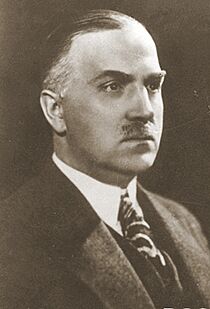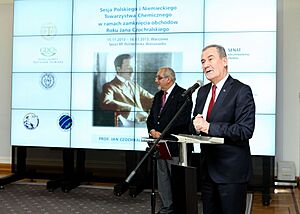Jan Czochralski facts for kids
Quick facts for kids
Jan Czochralski
|
|
|---|---|

Jan Czochralski ca. 1910
|
|
| Born | 23 October 1885 Exin, German Empire
|
| Died | 22 April 1953 (aged 67) Poznań, Poland
|
| Nationality | Polish |
| Citizenship | Polish |
| Alma mater | Technische Universität Berlin |
| Known for | Czochralski method B-metal |
| Spouse(s) | Marguerite Haase |
| Scientific career | |
| Fields | Chemistry, Metallurgy |
| Institutions | Warsaw University of Technology |
Jan Czochralski (23 October 1885 – 22 April 1953) was a famous Polish chemist. He invented the Czochralski method. This method is used to grow special crystals called single crystals. It's super important for making semiconductor wafers. These wafers are used in almost all electronics around the world.
Jan Czochralski is one of the most mentioned Polish scientists in research papers. He also helped two Jewish women hide in his home during the Warsaw Uprising. This saved them from danger during World War II.
Contents
Early Life and Discoveries
Jan Czochralski was born in 1885 in a town called Exin. This town is now known as Kcynia in Poland. Around 1900, he moved to Berlin, Germany. There, he worked in a pharmacy.
He studied at the Technische Hochschule in Charlottenburg. Today, this school is called Technische Universität Berlin. He became an expert in the chemistry of metals. In 1907, Czochralski started working as an engineer for a big company called Allgemeine Elektrizitäts Gesellschaft.
The Czochralski Method
Jan Czochralski made his most famous discovery in 1916. It happened by accident! He was working with molten tin. Instead of dipping his pen into his inkwell, he accidentally dipped it into the hot, melted tin.
When he pulled his pen out, a thin thread of solid metal was hanging from the pen's tip. He realized this thread was a single crystal. He then used a tiny tube, called a capillary, instead of his pen. His experiments created single crystals that were very thin but very long.
He wrote about his discovery in 1918. It was published in a German chemistry journal. At first, the method was used to measure how fast metals like tin, zinc, and lead crystallized. Years later, in 1948, two American scientists, Gordon K. Teal and J.B. Little, used his method. They grew single germanium crystals. This led to the method being used for making semiconductors.
Leading Research and B-Metal
In 1917, Czochralski started a research lab. He managed this lab until 1928. He also helped start the German Society for Metals Science in 1919. He was its president for many years.
In 1928, the president of Poland, Ignacy Mościcki, asked him to come back to Poland. Czochralski became a professor at the Warsaw University of Technology. He taught about metals and metal research.
In 1924, Czochralski invented a special metal alloy called B-metal. This metal was perfect for making bearings for train carriages. It was great because it didn't need expensive tin. The German railways were the first to buy his invention. B-metal helped trains go faster. It played a big part in making train travel better in Germany, Poland, the United States, the United Kingdom, and the Soviet Union.
His inventions brought him worldwide fame. In 1925, he became the president of the German Association of Metallurgists. Even Henry Ford invited him to visit his factories. Ford offered him a job as a director, but Czochralski said no.
After World War II, Jan Czochralski faced some difficulties. This was because of his work during the war. However, a Polish court later found him innocent of any wrongdoing. He then went back to his hometown of Kcynia. There, he ran a small business that made cosmetics and household cleaning products. He continued this until he passed away in 1953.
Remembering Jan Czochralski

Many places in Poland are named after Jan Czochralski. These include schools and streets in cities like Gdańsk, Poznań, Bydgoszcz, and Wrocław.
In 2009, the Polish Post released special stamps. One of these stamps, worth PLN 1.55, showed Jan Czochralski.
In 2012, the Polish Parliament decided that 2013 would be "The Year of Jan Czochralski."
In 2016, a team of Polish scientists found a new mineral. They named it czochralskiit to honor him. They found it in the Morasko Meteorite Nature Reserve.
In 2018, a comic book about his life was published. It was called Jan Czochralski. The Man Who Changed the World.
In 2019, a special plaque was placed at the Warsaw University of Technology. This plaque, from IEEE, honored Czochralski's scientific achievements. Also in 2019, a square in Toruń was named after him.
Citizenship
Jan Czochralski tried to give up his German citizenship. However, the process was not formally completed. His brother was killed by the Germans at the start of World War II.
See also
- List of Poles
- Timeline of Polish science and technology

